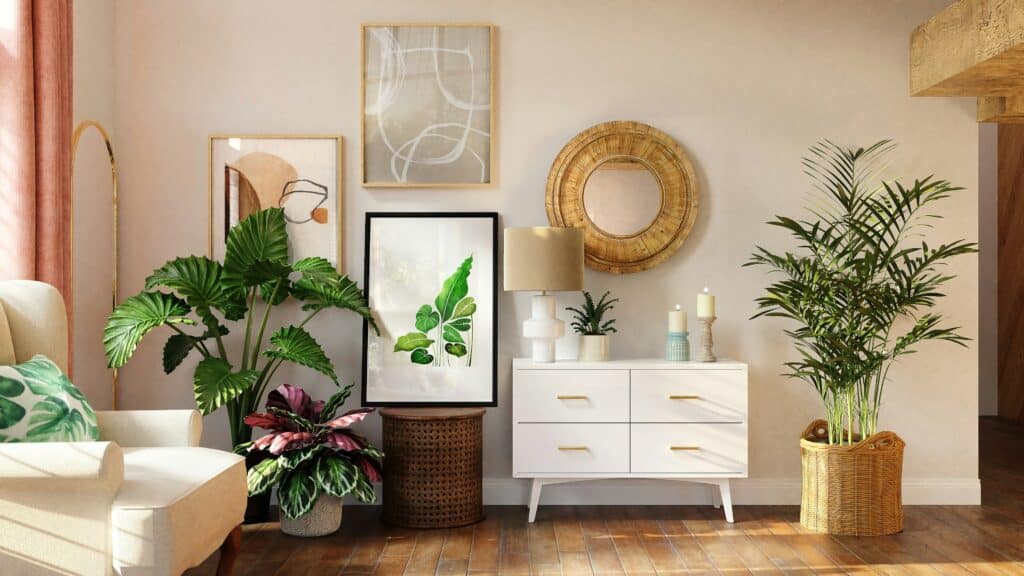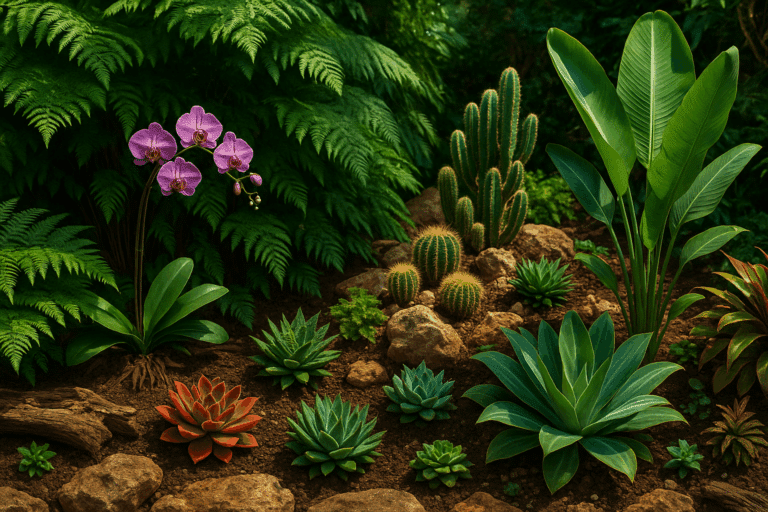Now picture achieving this with minimal effort and maintenance. Sound impossible? It’s not! Get ready to discover the magic and beauty of ZZ plants.
In the world of indoor plants, ZZ plants are treasured for their shiny, thick foliage and their ability to thrive in low light conditions. Known scientifically as Zamioculcas zamiifolia, these native African plants are perfect for creating an effortlessly stylish and elegant corner in your home or office.

The beauty of ZZ plants isn’t just about aesthetics. They also come with a wealth of health benefits. They are excellent air purifiers, removing toxins such as xylene, toluene, and benzene from the air, helping you breathe easier. Besides, their green color can create a calming environment, reducing stress and increasing productivity.
In this upcoming discussion, we’ll delve into everything you need to know about ZZ plants. From their history, ideal care and maintenance practices, potential health benefits, and tips to incorporate them into your interior decor. Stay tuned, and let’s embark on this journey to making greenery easy and stylish with low maintenance needs.
Understanding the ZZ Plant
The ZZ plant, scientifically known as Zamioculcas zamiifolia, is a popular indoor plant due to its aesthetic appeal and low maintenance requirements. Originating from East Africa, this perennial plant has adapted well to indoor environments across the globe.
A defining feature of the ZZ plant is its glossy, dark green leaves that grow on sturdy, vertical stems. The plant’s leaves have a unique waxy finish, giving them an almost artificial look, and their growth pattern creates a beautiful, feathery display.
ZZ Plant Growth and Light Requirements
The ZZ plant is a slow-growing species, generally reaching a height of 2-3 feet when grown indoors. One of the key advantages of this plant is its ability to thrive under a variety of light conditions. It can grow in low light, but for optimal growth, bright, indirect light is recommended. However, direct sunlight should be avoided as it can scorch the plant’s leaves.
Watering and Soil Needs
The ZZ plant is a drought-tolerant species, thanks to its rhizomatous roots which store water. This means it requires less frequent watering compared to other houseplants. Overwatering can lead to root rot, a common problem for this plant.
The soil needs of the ZZ plant are equally straightforward. It prefers well-draining soil to prevent waterlogging. A standard potting mix combined with a bit of sand or perlite can provide the necessary drainage.
ZZ Plant Propagation
Propagation of the ZZ plant is a simple process. The most common method is through leaf cuttings. A single leaf, when planted in moist soil, can grow into a new plant. This, however, can take a long time. For faster propagation, division of the rhizomes can be done.
Handling Common ZZ Plant Problems
Despite its robustness, the ZZ plant can occasionally encounter problems. Yellowing leaves are usually a sign of overwatering, while browning leaf tips can indicate low humidity.
One way to increase humidity around the plant is by using a pebble tray filled with water. Another way is to occasionally mist the plant with water. If pests like aphids or mealybugs are noticed, a simple solution of water and mild dish soap can be used to wash off the insects.
Managing ZZ Plant Toxicity
It’s important to note that all parts of the ZZ plant are poisonous if ingested. Therefore, it should be kept away from children and pets. In case of contact with the sap, it can cause skin irritation, so it’s recommended to wear gloves when handling the plant.
Benefits of Having a ZZ Plant
Apart from its aesthetic appeal, the ZZ plant has been found to have impressive air-purifying properties. A study conducted by NASA as part of their Clean Air Study revealed that many indoor plants, including ZZ plants, are capable of removing airborne toxins such as xylene, toluene, and benzene. These volatile organic compounds, commonly found in paints, solvents, and household cleaners, can contribute to indoor air pollution. By filtering out these harmful substances, ZZ plants help create a healthier environment in both homes and workspaces.
Additionally, ZZ plants are known to release oxygen during the day through photosynthesis and may continue low-level respiration at night. While not a dramatic air purifier on its own, when included as part of a broader indoor plant collection, the ZZ plant contributes meaningfully to overall air quality.
Another less-known benefit of the ZZ plant is its impact on mental health. Studies have shown that being surrounded by greenery can help reduce stress, anxiety, and symptoms of depression. The presence of plants indoors has been linked to lower heart rates and improved cognitive function. The soothing green color and natural form of the ZZ plant offer a visual break from digital screens and artificial interiors, helping to promote relaxation and focus.
Because ZZ plants are so low-maintenance, they also provide a sense of accomplishment and satisfaction without the stress that high-maintenance plants can sometimes cause. For people with demanding schedules or those who travel frequently, the ZZ plant offers the joy of plant ownership without requiring constant care.
Creating Your ZZ Plant Corner
Designing a ZZ plant corner is an enjoyable and impactful way to incorporate greenery into your living space. These plants are remarkably flexible in terms of placement and aesthetic compatibility, allowing you to tailor your green corner to suit virtually any room or design preference.
Choosing the Right Location
The first step in creating a ZZ plant corner is identifying an appropriate location. Ideally, the spot should receive bright, indirect sunlight, but thanks to the ZZ plant’s adaptability, it can also tolerate low-light conditions. This makes them suitable for corners that are not directly adjacent to windows or receive only filtered light through curtains or blinds.
Avoid placing your ZZ plant in direct sunlight, particularly through west-facing windows, as prolonged exposure to intense rays can scorch its leaves. If your chosen corner has very little natural light, consider using a full-spectrum LED grow light for a few hours each day to supplement the plant’s needs.
ZZ plants also prefer a stable indoor temperature between 65 and 80 degrees Fahrenheit. Avoid spots near heating or cooling vents, or areas that experience frequent drafts, as fluctuating temperatures can stress the plant.
Selecting ZZ Plant Varieties and Sizes
Though often thought of as a single plant type, the ZZ plant actually includes a few variations that differ in size and appearance. The standard ZZ plant is the most common, featuring robust stems and deep green leaves. However, there are also dwarf versions, which are perfect for tabletops, and the popular Raven ZZ, which boasts dark purple-black foliage and provides a dramatic contrast to lighter interiors.
Mixing various sizes can add depth and visual intrigue to your ZZ plant corner. Larger ZZ plants can serve as anchor pieces in floor pots, while smaller ones add detail and variety when placed on floating shelves, windowsills, or accent tables.
For a cohesive look, choose plants at different heights and place them in containers of varying sizes and materials that reflect your interior style. For a minimalist look, stick with neutral ceramics or matte finishes. For a more eclectic vibe, try woven baskets, hand-painted planters, or vintage-inspired pots.
Pot Selection and Soil Considerations
A visually appealing ZZ plant corner is not just about the plants themselves. The pots and containers you choose play a vital role in the design. Since ZZ plants require well-draining soil and are prone to root rot if left in soggy conditions, the pots must have adequate drainage holes.
Opt for containers made from breathable materials like terracotta or unglazed clay if you tend to overwater. These materials help wick moisture away from the soil and reduce the risk of overwatering. If you prefer ceramic or decorative outer pots without drainage holes, ensure you use a plastic nursery pot with drainage inside them so water can be easily removed.
As for soil, use a loose, well-draining mix. A standard indoor potting soil combined with a bit of perlite, pumice, or coarse sand works well. Avoid moisture-retaining mixes or soils meant for tropical plants that like damp environments, as these will hold too much water for ZZ plants.
Layering and Styling with Complementary Plants
One of the best ways to enhance your ZZ plant corner is by incorporating other low-maintenance plants with complementary appearances and care needs. Snake plants, for example, share the ZZ plant’s ability to tolerate low light and infrequent watering. Their upright, sword-like leaves offer contrast in shape and texture.
Pothos, with its trailing vines and variegated leaves, adds softness and movement to the composition. Its cascading form makes it a great companion for placing on high shelves or wall-mounted planters in your green corner.
Peace lilies, philodendrons, and even cast-iron plants can round out the collection with diverse foliage colors and forms while maintaining a consistent low-care routine. Be sure to leave adequate space between plants for airflow and access, and avoid overcrowding the corner, which can lead to pest problems or create a cluttered look.
Decorative Elements to Enhance Your ZZ Corner

To take your ZZ plant corner to the next level, consider incorporating design elements that create a warm, finished look. These additions help create a cozy, curated space that reflects your personality and complements your interior style.
Lighting
Accent lighting is a great way to highlight your plant corner and create ambiance. Use a small table lamp with a soft bulb, LED grow lights in warm tones, or even fairy lights woven through the base of your plants to make the space glow in the evening.
If you prefer natural tones, bamboo or wood-framed lamps can echo the organic aesthetic of the plants. For modern interiors, choose sleek, black metal fixtures or minimalist designs that don’t draw attention away from the foliage.
Plant Stands and Furniture
Elevating some of your ZZ plants on plant stands adds height variation and helps fill vertical space. Tiered plant stands, ladder shelves, or even repurposed furniture pieces like side tables or stools can all serve as platforms to display your plants at different levels.
This layering effect prevents a flat or monotonous look and draws the eye upward, making even a small space feel more dynamic and alive.
Artwork and Accessories
If your plant corner is near a wall, consider adding botanical prints, framed photos, or plant-themed artwork to tie the area together. Mirrors can also be used creatively to reflect light and make the space appear larger while showcasing more angles of your lush greenery.
Incorporate small accessories like ceramic figurines, vintage watering cans, or nature-inspired sculptures to create visual interest. Just be sure not to clutter the space—each element should enhance the plants, not compete with them.
Practical Tips for ZZ Plant Success
Even though ZZ plants are considered one of the easiest indoor plants to grow, a few simple practices will keep them thriving for years to come.
- Rotate your plant every few weeks to ensure even growth on all sides
- Wipe down the leaves periodically with a damp cloth to remove dust and maintain their glossy appearance
- Monitor for signs of stress, such as yellowing or curling leaves, which usually indicate watering or light issues
- Repot the plant every two to three years to refresh the soil and allow room for new rhizome development
For pet owners, remember to position ZZ plants in locations out of reach, as they can be mildly toxic if ingested. Childproofing your plant corner may also involve placing plants on high shelves or using barrier stands.aintenance plant that’s perfect for anyone wanting to bring some greenery into their home.
Conclusion
The ZZ Plant Corner brings a breath of fresh air to any space with its effortlessly stylish appearance and low maintenance needs. This corner of greenery can effortlessly elevate the aesthetics of your home or office, adding a touch of nature-inspired beauty that is sure to impress. The ZZ plant’s minimal care requirements make it an ideal choice for both seasoned plant enthusiasts and beginners alike. It’s resilient, hardy, and can thrive even with less-than-perfect care, truly embodying the spirit of “greenery made easy.”
Moreover, this plant’s versatile design compatibility means it can seamlessly blend into a variety of decor styles, from modern minimalist to boho chic. It’s not just about the aesthetic appeal though; ZZ plants also contribute to a healthier indoor environment by purifying the air and increasing humidity levels. In a world where wellness is increasingly becoming a priority, the ZZ Plant Corner offers an effortless way to embrace a greener, healthier lifestyle.
So, whether you’re looking to spruce up your interiors, seeking a new plant to add to your collection, or just wanting to enjoy the calming effect of greenery, the ZZ Plant Corner is a choice you won’t regret. After all, there’s nothing like the timeless beauty of nature to add a touch of elegance and tranquility to any space.



